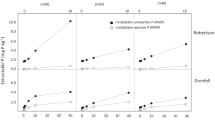Summary
A scarcity of available phosphorus often limits plant growth, and organic forms of phosphorus are not generally thought to be important direct sources of phosphate for plants. A dominant arctic tundra plant, Eriophorum vaginatum, is able to hydrolyze and absorb phosphate from a naturally occurring organic phosphorus compound at concentrations as low as those found in soil solution and at rates comparable to its ability to absorb inorganic phosphate. Calculations show that in tundra soils, where organic phosphorus is typically the predominant form of phosphorus in soil solution, E. vaginatum's root surface phosphatases may be capable of providing from organic phosphorus up to 69% of the plant's annual phosphorus demand.
Similar content being viewed by others
References
Anderson G, Williams EG, Moir JO (1974) A comparison of the sorption of inorganic orthophosphate and inositol hexaphosphate by six acid soils. J Soil Sci 25:51–62
Barel D, Barsdate RJ (1978) Phosphorus dynamics of wet coastal tundra soils near Barrow, Alaska. In: Adriano DC, Brisbin IL Jr (eds) Environmental Chemistry and Cycling Processes. U.S. Department of Energy Symposium Series CONF-760429, Washington, D.C., pp 516–537
Bartlett EM, Lewis DH (1973) Surface phosphatase activity of mycorrhizal roots of beech. Soil Biol Biochem 5:249–257
Chapin FS III, Tryon PR(1982) Phosphate absorption and root respiration of different plant growth forms from northern Alaska. Ecol 5:164–171
Chapin FS III, Van Cleve K, Chapin MC (1979) Temperature and nutrient cycling in the tussock growth form of Eriophorum vaginatum.J Ecol 67:169–189
Dracup MNH, Barrett-Lennard EG, Greenway H, Robson AD (1984) Effect of phosphorus deficiency on phosphatase activity of cell walls from roots of subterranean clover. J Exp Bot 35:466–480
Epstein E, Schmid WE, Rains DW (1963) Significance and technique of short-term experiments on solute absorption by plant tissue. Plant Cell Physiol 4:79–84
Estermann EF, McLaren AD (1961) Contribution of rhizoplane organisms to the total capacity of plants to utilize organic nutrients. Plant Soil 15:243–260
Greaves MP, Anderson G, Webley DM (1963) A rapid method for determining phytase activity of soil micro-organisms. Nature 200:1231–1232
Hall JL, Butt VS (1968) Localization and kinetic properties of β-glycerophosphatase in barley roots. J Exp Bot 19:276–281
Halstead RL, McKercher RB (1975) Biochemistry and cycling of phosphorus. In: Paul EA, McLaren AD (eds) Soil Biochemistry, vol 4. Marcel-Dekker Inc., New York, pp 31–63
Hannapel RJ, Fuller WH, Bosma S, Bullock JS (1964) Phosphorus movement in a calcareous soil: 1. Predominance of organic forms of phosphorus in phosphorus movement.Soil Sci 97:350–357
Kroehler CJ, Linkins AE (1988) The root surface phosphatases of Eriophorum vaginatum: Effects of temperature, pH, substrate concentration and inorganic phosphorus. Plant Soil 105:3–10
Martin JK (1970) Preparation of 32P-labeled inositol hexaphosphate. Anal Biochem 36:233–237
Martin JK (1973) The influence of rhizosphere microflora on the availability of 32P-myoinositol hexaphosphate phosphorus to wheat. Soil Biol Biochem 5:473–483
Martin JK, Cartwright B (1971) The comparative availability of 32P myo-inositol hexaphosphate and KH2 32PO4 added to soils. Soil Sci Plant Anal 2:375–381
Nye PH (1977) The rate-limiting step in plant nutrient absorption from soil. Soil Sci 123:292–297
Ridge EH, Rovira AD (1971) Phosphatase activity of intact young wheat roots under sterile and non-sterile conditions. New Phytol 70:1017–1026
Stevenson FJ (1986) Cycles of Soil: C, N, P, S, Micronutrients. John Wiley and Sons Inc., New York
Tamura T, Minamikawa T, Koshiba T (1982) Multiple forms of acid phosphatase in cotyledons of Vigna mungo seedlings. J Exp Bot 33:1332–1339
Wein RW (1973) Biological flora of the British isles: Eriophorum vaginatum L. J Ecol 61:601–615
Wood T (1961) A procedure for the analysis of acid-soluble phosphorus compounds and related substances in muscle and other tissues. J Chromatog 6:142–154
Author information
Authors and Affiliations
Rights and permissions
About this article
Cite this article
Kroehler, C.J., Linkins, A.E. The absorption of inorganic phosphate from 32P-labeled inositol hexaphosphate by Eriophorum vaginatum . Oecologia 85, 424–428 (1991). https://doi.org/10.1007/BF00320620
Received:
Accepted:
Issue Date:
DOI: https://doi.org/10.1007/BF00320620




